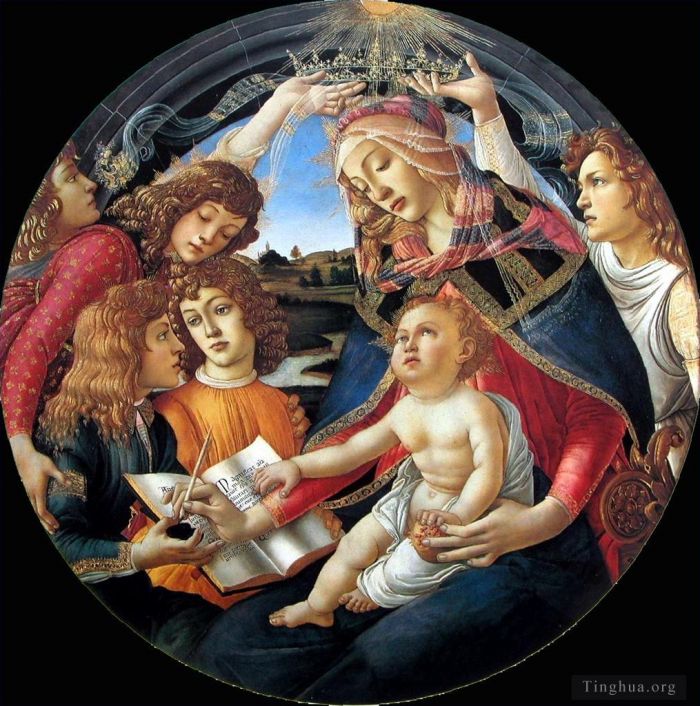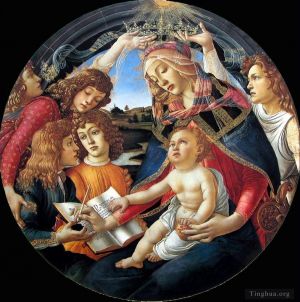Madonna of The Magnificat
Sandro Botticelli
- Price: Price on Request
- Art Type: Various Paintings
- Size:
- English Comments: 0
- International Comments: 0
- Creating Date:
- Introduction and Works of Sandro Botticelli >>
Keywords:
Madonna, Magnificat
Work Overview
- Madonna of the Magnificat
Artist Sandro Botticelli
Year 1481
Medium Tempera
Dimensions 118 cm × 119 cm (46 in × 47 in)
Location Uffizi, Florence
Painted sometime between 1481 and 1485, the painting gets its title from the book open at the page of the "Magnificat". At the Uffizi since 1815.
The Madonna of the Magnificat, Italian: Madonna del Magnificat, is a painting of circular or tondo form by the Italian Renaissance painter Sandro Botticelli. It is now in the galleries of the Uffizi, in Florence.
The work portrays the Virgin Mary crowned by two angels. She is writing the opening of the Magnificat on the right-hand page of a book; on the left page is part of the Benedictus. In her left hand she holds a pomegranate.[1] Mary is thought to be a portrait of Lucrezia Tornabuoni, wife of Piero de' Medici, and the two angels holding the book to be her sons Lorenzo and Giuliano.
The history of the painting is not known. It was acquired by the Uffizi in 1785 from Ottavio Magherini.[2] It may have come from one of the many monasteries suppressed by the Archduke Pietro Leopoldo. It has been identified with the tondo in the church of San Francesco al Monte mentioned by Vasari and Bocchi, but the description does not coincide and this identification is usually rejected. There are several copies of the painting, including one in the Louvre, one in the Pierpont Morgan Library in New York.
Botticelli created his Madonna del Magnificat in the early 1480s. At the time, it was in all likelihood his most famous picture of the Virgin, something indicated by the five contemporary replicas which we have of the painting.
The painting was lavishly covered with gold paint; like the Raczynski Tondo, it contains nearly life-size figures. The Virgin, crowned by two angels, is depicted as the Queen of Heaven. Two of the wingless angels are crowning the Queen of Heaven. The crown she is wearing is a delicate piece of goldsmiths work consisting of innumerable stars; they are an allusion to the 'Stella matutina' (morning star), one of the Mother of God's names in contemporary hymns devoted to Mary.
There is such a complex solution to the sequence of crowded figures in front of the stone window that it is possible to look out between Mary and the angels on the left onto a broad landscape laid out according to the rules of atmospheric perspective. The three angels have moved towards the Virgin and Child. The one at the front is kneeling and holding an open book and inkwell. Encouraged by the Christ Child, the Virgin is about to dip her quill and write the last words of the Magnificat, beginning on the right page with the large initial "M". The pomegranate which the mother and child are both holding is a symbol of the Passion and adds to the basic melancholy and meditative mood of the painting.
The background of the picture opens out into a landscape, in similar manner to the background in the Madonna del Libra where the open window allows the observer a glimpse of the view outside. These landscapes point to the influence exerted upon Botticelli by contemporary Netherlands' artists such as Jan van Eyck, Rogier van der Weyden and Hubert van der Goes. Trading relations between Italy and the Netherlands had been growing more intensive since the 15th century, resulting in many Florentine merchants and bankers travelling northwards. Among the mementos which these people brought back were paintings revealing other artistic conceptions and ideals. The Italian painters particularly admired the detailed execution of individual pictorial motifs, the realistic fashioning of the figures in the pictures, and the atmospheric effect of the landscapes as rendered in the art of their colleagues north of the Alps, and each incorporated the motifs of the latter into his own pictures after his own manner.
This portrait of the Virgin represents the costliest tondo that Botticelli ever created: in no other painting did he employ so much gold as in this one, using it for the ornamentation of the robes, for the divine rays, and for Mary's crown, and even utilizing it to heighten the hair colour of Mary and the angels. As the most expensive paint, gold was normally used only sparingly. Its liberal employment here will therefore have been at the express wish of the person commissioning the work.
- Copyright Statement:
All the reproduction of any forms about this work unauthorized by Singing Palette including images, texts and so on will be deemed to be violating the Copyright Laws.
To cite this webpage, please link back here.
- >> English Comments
- >> Chinese Comments
- >> French Comments
- >> German Comments
- >>Report
- Pallas and the centaur
- The Calumny of Apelles
- Killing the woman (The Story of Nastagio degli Onesti - second episode)
- Nastagio meets the woman and the knight in the pine forest of Ravenna (The Story of Nastagio degli Onesti - first episode)
- The Birth Of Venus
- Primavera
- Discovery of murder Holophernes
- The banquet in the forest (The Story of Nastagio degli Onesti - third episode)
- Madonna And Child With An Angel 2
- Sandro Portrait of a young man
- Portrait of a young man
- Madonna In Glory With Seraphim
- The Temptation of Christ
- The Discovery Of The Murder Of Holofernes
- The Cestello Annunciation
- Adoration of The Magi
- Madonna della Loggia (Madonna and Child)
- Marriage of Nastagio degli Onesti (The Story of Nastagio degli Onesti - fourth episode)
- The Trials of Moses (The Youth of Moses)
- Madonna and Child with Six Saints (Sant Ambrogio Altarpiece)
- Portrait of a young man 1483
- Madonna And Child With An Angel
- Portrait of an young woman
- Venus and Mars
- Punishment of the Rebels (The Punishment of the Sons of Corah)
- Adoration Of The magi
- Madonna of the Rose Garden
- Simonetta
- Virgin and Child with an Angel (Our Lady of the Eucharist)
- Madonna And Child And Two Angels
- The Return Of Judith To Bethulia
- The Mystical Nativity
- Fortitude
- Sixtus II
- Guliano de Medici
- Madonna of the Book (The Virgin and Child)
- The Virgin And Child With Two Angels
- Madonna of The Magnificat
- Madonna with Child and five angels (The Virgin and Child surrounded by Five Angels)









 Singing Palette
Singing Palette